Why Most Tourism SEO Strategies Fail And How To Fix Them (With A Personalized SEO Weakness Quiz)
by
Jeremy Tang - Updated
15-Oct-2024
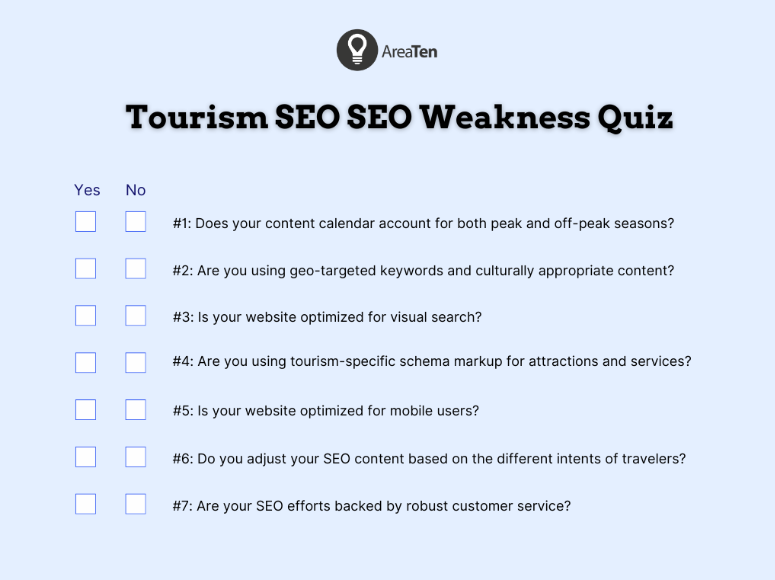
Most tourism SEO strategies fail because they rely on generic approaches that don’t adapt to the unique seasonal, cultural, and mobile needs of the travel industry. By targeting geo-specific keywords, optimizing for mobile and visual search, and using tourism-specific schema markup, you can significantly improve search visibility and conversions.
Tourism SEO isn’t just another marketing tactic—it’s the strategy that determines whether your travel business thrives or fades into the background.
So, why do some tourism websites soar to the top of search results while others barely make a splash? It all comes down to mastering SEO strategies that are custom-built for the tourism industry.
In the travel industry, search patterns fluctuate with peak seasons, consumer preferences, and even unexpected global events. A generic, one-size-fits-all SEO approach just won’t cut it here. You need a strategy as dynamic as your audience—one that evolves with seasonal trends and anticipates customer needs before they even hit “search.”
When it comes to SEO for travel agency companies and other tourism businesses, most strategies fall flat because they rely on cookie-cutter approaches.
That’s why we’ve created a quiz designed to uncover the specific gaps in your tourism SEO strategy, allowing you to pinpoint exactly where you’re losing traction and why. Through this simple quiz, you’ll see how honing in on industry-specific details can make all the difference in the potency of your SEO efforts.

Download your own printable copy here: Tourism SEO SEO Weakness Quiz
As you go through the quiz and follow along with the article, you’ll get personalized recommendations based on your responses. Once you know where to focus your efforts, your rankings and conversions will improve, and your business will be set for long-term success.
When it comes to SEO services in Gold Coast, or anywhere else in the world for that matter, many miss a crucial piece of the puzzle: timing.
The ebb and flow of consumer interest throughout the year—driven by holidays, school breaks, and local events—can have a massive impact on search behavior. For example, search terms like “hotel Torquay” spike during the summer months when tourism is at its peak, only to taper off in the colder months.
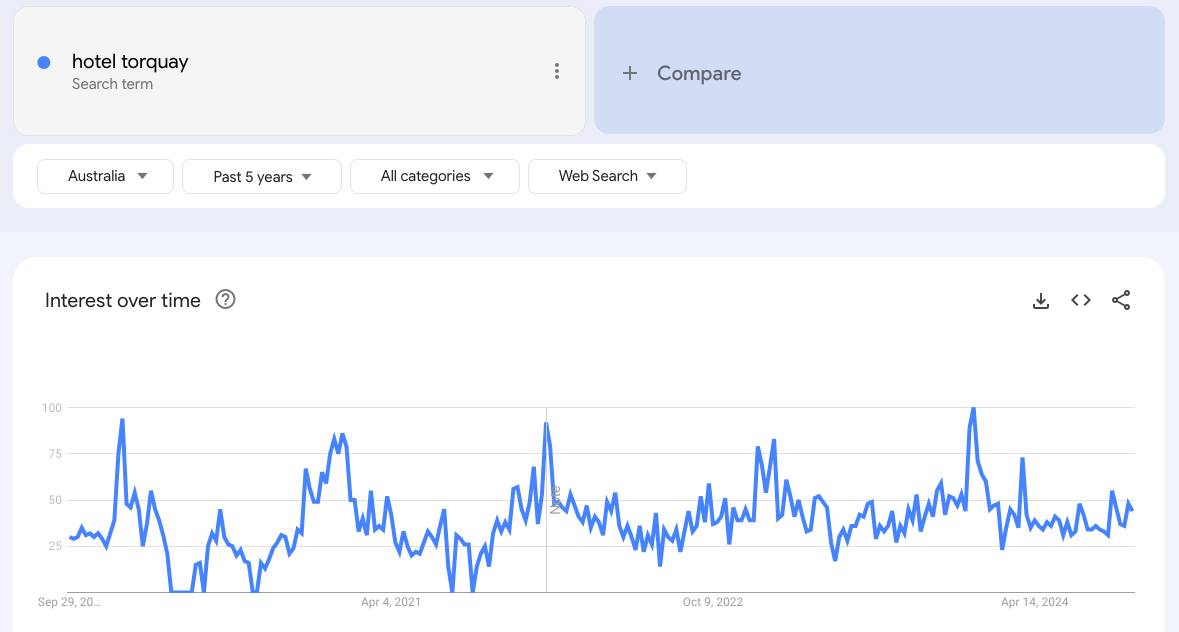
If you’re not paying attention to these trends, you’re leaving a lot on the table in terms of aligning your content with what people are actually searching for.
The problem for many businesses is that they get tunnel vision when it comes to SEO, focusing all their energy on peak periods and completely forgetting about the off-season. It’s natural to zero in on those high-traffic times of the year—after all, that’s when your site’s buzzing, right? However, you’re missing out if you’re ignoring the quieter times.
Even when the frenzy dies down, there’s still demand.
Travelers are out there looking for early bird specials, off-peak travel experiences, and hidden gems away from the crowds. Throw in some unexpected factors—like a local festival popping up or a sudden change in the weather—and boom, you’ve got yourself an opportunity to shine when others are taking a break.
First off, it’s crucial to know when the high and low seasons are in your target areas. Mapping these out lets you tailor your marketing to fit when your audience is most active.
Don’t forget to spotlight regional events and attractions in your local SEO strategy year-round, too. Promoting local festivals or unique food and drink experiences can really make a difference when it comes to attracting visitors, especially during seasonal lows.
In the past couple of years, location-based searches containing the terms “near me” or “close by” have surged by a whopping 900% (Source: WebFX).
Yet, so many tourism businesses make the mistake of relying solely on users’ default search settings, focusing on just their Google Business Profile while leaving out key geo-targeted keywords in their content. If you’re not sprinkling in specific terms like “boutique hotel in [City]” or “private tours near [Landmark],” you’re missing out.
You see, both domestic and international travelers often use phrases like these when they’re mapping out their trip. They’re actively searching for information that’s critical to their trip beforehand, like the best hotels, services, and experiences in the area, and you want to make sure your business shows up when they do.
If you’re already using geo-targeted phrases, keep it up. It’s a simple tactic, but it’s undoubtedly effective in helping you draw the right audience.
One of the biggest mistakes in tourism marketing is forgetting about cultural differences.
If you’re not careful, you can completely alienate your international audience. And believe me, that’s not a small thing when you think about the size of the global tourism market. It was worth a whopping USD$11.39 trillion in 2023, and it’s only projected to grow even further to USD$18.44 trillion by 2032 (Source: Zion Market Research).
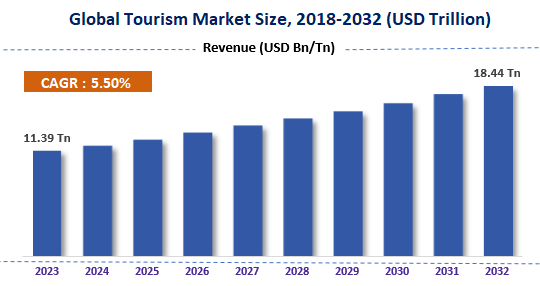
Source: Zion Market Research
To drive home how important cultural nuances are, consider this example: A Japanese traveler might be on the hunt for a cozy “ryokan near Tokyo,” while a European tourist might be more focused on finding “budget hostels in Tokyo.” Same destination, completely different expectations. The point is, understanding these differences in what your audience values is huge for connecting with them.
It’s not just about translating your content, either.
Sure, you want to speak their language (literally and figuratively), but it goes deeper than that. Cultural sensitivity means catering to their specific needs, their preferences, and the unique experiences they’re looking for.
This needs to be reflected in your website’s content, from the way you describe accommodations and activities to how you highlight local customs and traditions. The best kind of SEO copywriting helps potential customers make an informed decision, increasing the likelihood that they’ll choose your business for their travel plans.
If you’re not taking cultural nuances into account in your SEO and content strategy, you risk coming across as irrelevant, and this could cost you a massive chunk of international traffic.
It’s all about using the right keywords.
Instead of broad phrases like “top tourist spots,” focus on specific city or landmark keywords like “best guided tours in [City]” or “family-friendly attractions near [Landmark].” These more precise terms will match what travelers are actually searching for, boosting your visibility where it matters.
You’ll also want to create content that’s culturally engaging.
Think about what makes your business appealing on a global scale—like being close to famous hotspots or offering personalized experiences that cater to international guests. Highlight those details, and you’ll connect with travelers from all over.
The goal here is to adapt, refine, and make sure international travelers see content that speaks directly to them.
These days, travelers are all about visuals when making decisions.
Google Image Search now makes up about 10% of all Google searches (Source: Neil Patel), which really shows how important it is to have strong visual content if you want to boost your search visibility. Using high-quality images and videos doesn’t just make your site look good—it also grabs people’s attention and can help improve your rankings in visual search results.
It gets even better: visuals can get you up to 94% more views compared to text alone (Source: WebFX).
This means better engagement, more clicks, and higher dwell time on your site—all of which are crucial for improving your SEO rankings. The richer the experience you offer, the better chance you have of keeping visitors around.
If you’re aiming to make your website more visually appealing and optimized for SEO, here’s how you can up your game:
When it comes to tourism-specific searches, using general schema markup like article or review schema just doesn’t cut it.
While they help search engines categorize content, they don’t tell Google exactly what your content is about—especially if you’re in the tourism industry. But don’t worry; there are tourism schemas you can use.
If someone’s searching for details about a local tourist attraction or event, they’re looking for specific details like opening hours, location, or related events. Applying schemas like “tourist attraction,” “travel agency” or “event” helps search engines understand this and makes your content more relevant.
The more relevant you are, the better your search visibility, which means your site is more likely to show up for those targeted queries.
And here’s the kicker—when you use these tailored schemas properly, you’re unlocking the potential for richer search results. Think maps, reviews, photos, operating hours—those things that help users make decisions faster. These richer search results have also been shown to get up to 82% more clicks than the standard listings (Source: Google Search Central), so aiming to get them is pretty much mandatory.
Tailoring schema markups to match your business offerings is key to getting the right kind of visibility in search results.
For instance, if you’re managing a vacation rental, using vacation rental schema can showcase important details like availability, pricing, and amenities directly on the search engine results page. The same goes for things like event hosting—just add event schema, and you can highlight details like dates and locations, making it easy for potential attendees to find and engage with your event.
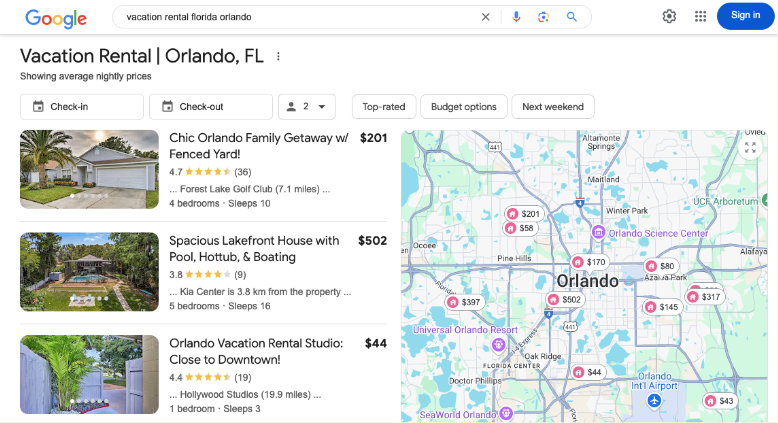
Focusing on these specific schema types puts your services right in front of people who are actively searching for them. And while it’s possible to implement schema markup yourself, following a guide or partnering with a good tourism SEO agency ensures accuracy and efficiency. Our guide on using ChatGPT for schema markup offers helpful insights if you want to give it a try.
Let’s be real: everyone’s glued to their phones these days.
Whether they’re hunting for the best local restaurant, a cozy hotel, or directions to that must-see attraction, your potential customers are using mobile devices to get answers now. What’s more, Google reports that more than 50% of searches come from mobile devices. So, if your site loads quickly and works smoothly on smaller screens, you’re already ahead of the game.
And here’s a little secret weapon you can add to the mix: live chat.
This allows your site visitors to get quick, real-time answers to their questions while they’re already browsing your offerings. It’s like having a personal assistant for every potential customer, ready to help them make a decision on the spot. Plus, when you’re proactive with your website users, engagement rates can skyrocket by up to seven times (Source: Greechat).
If you’re ignoring mobile optimization, you’re ignoring most of today’s online audience. It’s time to get it sorted.
Mobile users aren’t exactly patient, so if your site takes forever to load, has text that’s hard to read, or is just a pain to navigate, they’ll leave in no time. For tourism businesses, not being mobile-friendly could even mean getting dropped from mobile search results, which is where most people are looking for info these days.
The fix is pretty straightforward: make sure your website uses responsive design, so it automatically adapts to any screen size. This creates a seamless experience, whether someone is using a phone, tablet, or desktop.
If you want to make sure everything is working correctly, a tool like Google’s Mobile-Friendly Test can help you identify where improvements are needed. Bonus: take advantage of our roadmap that can help improve your SEO in six weeks.
One of the biggest mistakes tourism companies make is casting their net too wide and hoping for the best with broad keywords like “best hotels” or “top destinations.”
But here’s the thing: this fails to address the diverse needs of different types of travelers.
A business traveler, for example, likely won’t be looking for an oceanfront view; “meeting-friendly hotels in Sydney” might be a better fit. Meanwhile, a family planning a beach vacation is probably Googling “best resorts for families in Bali.” Different strokes for different folks, right?
The trick here is understanding the variety of reasons behind why people travel. Business travelers likely care about amenities that make work easy, while solo travelers tend to look for safety or a social vibe. If your content can speak to these individual desires, you’re hitting the nail on the head.
Intent-driven SEO is your ticket to higher engagement and better conversion rates—because when you speak your audience’s language, they’ll listen.
Ignoring search intent can be a costly oversight.
When you target long tail keywords, you’re essentially getting insights into what specific types of travelers want. These longer, more detailed search queries give you a crystal-clear picture of where they are in their decision-making process. When you know what travelers are looking for, you can tailor your content to meet their exact needs, right when they need it.
Once you’ve got a clear picture of what they want, it’s time to craft content that hits the mark.
For instance, you can create dedicated landing pages for niche searches like “all-inclusive corporate retreats” or “adventure trips for solo travelers.” These pages should directly address their needs with relevant, to-the-point content.
Incorporating strong customer service directly into your SEO strategy can make all the difference, especially in fast-paced sectors like tourism.
When a potential traveler is booking a trip, there’s a lot of uncertainty and last-minute decisions involved. Having a tool like a 24/7 live chat feature at their fingertips? That’s a game-changer. It gives them immediate answers and makes the whole process feel smooth and secure, which can often be the deciding factor in whether they choose your service or head to a competitor.
With live chat features being the preferred mode of communication of 46% of users (Source: SuperOffice), it’s definitely one of the best things you can include in your website if you’re looking to improve the customer experience.
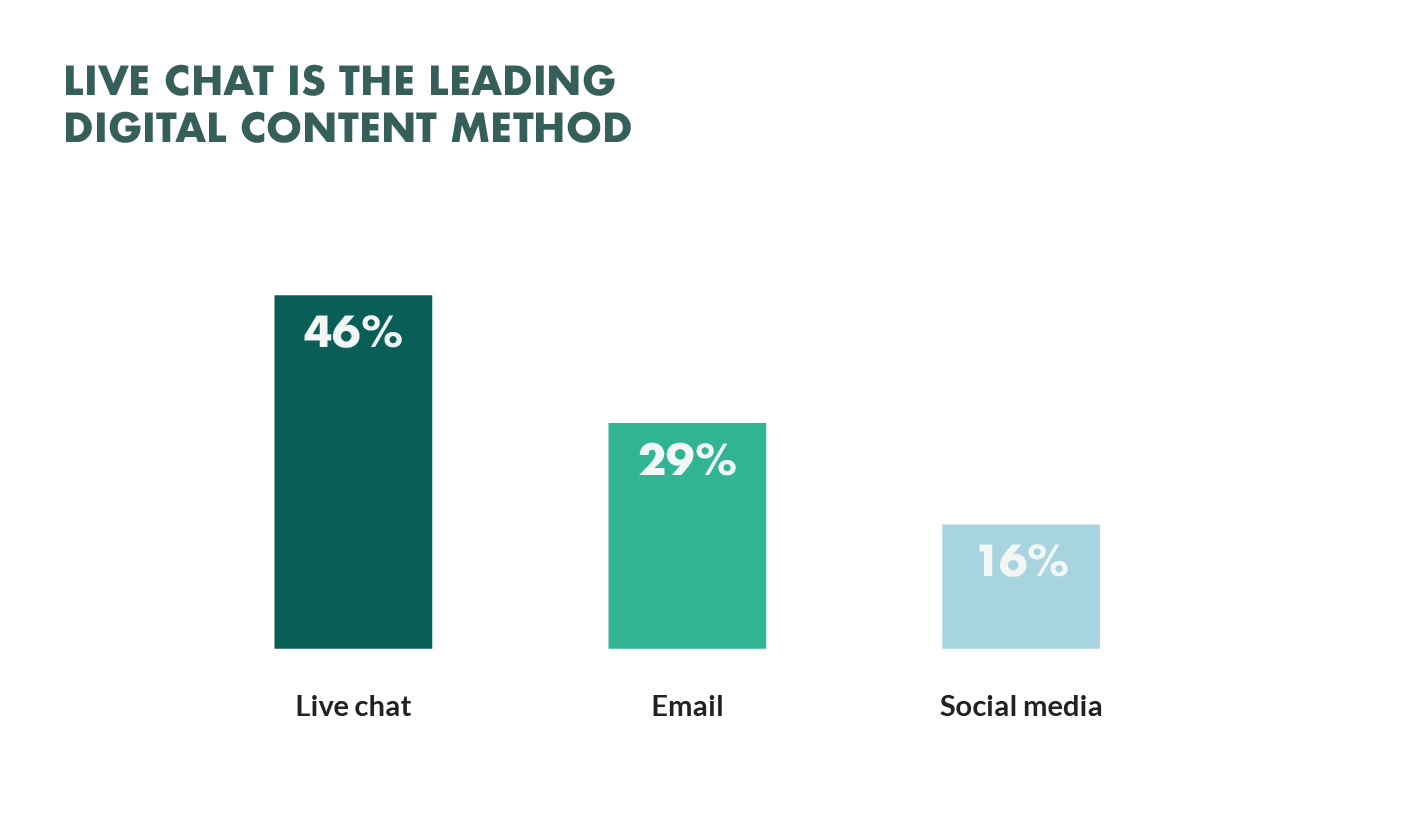
The real power of live chat is the reassurance it provides. When visitors feel that they can get help instantly, they trust your service more. That trust builds confidence, and confidence is what turns a casual browser into a paying customer.
Sure, your SEO might be bringing people to your site, but without solid customer support, you could be losing potential clients just as quickly as they arrive.
Think about it—travelers are often unsure or have questions, and if they can’t get quick answers, they’ll likely just move on. This can spike your bounce rates, undoing all the hard work your SEO is doing to get you noticed in the first place.
The simple fix? Integrate robust customer service options into your site—live chat or clear contact forms. These little additions make a massive difference in keeping visitors engaged, encouraging conversions, and ultimately supporting your SEO strategy.
Making sure people can easily reach out for assistance will turn curious visitors into happy customers—and that’s what really boosts your bottom line. So, don’t let a lack of support be the reason you miss out on bookings.
Our solutions table will help identify and address your SEO weaknesses.
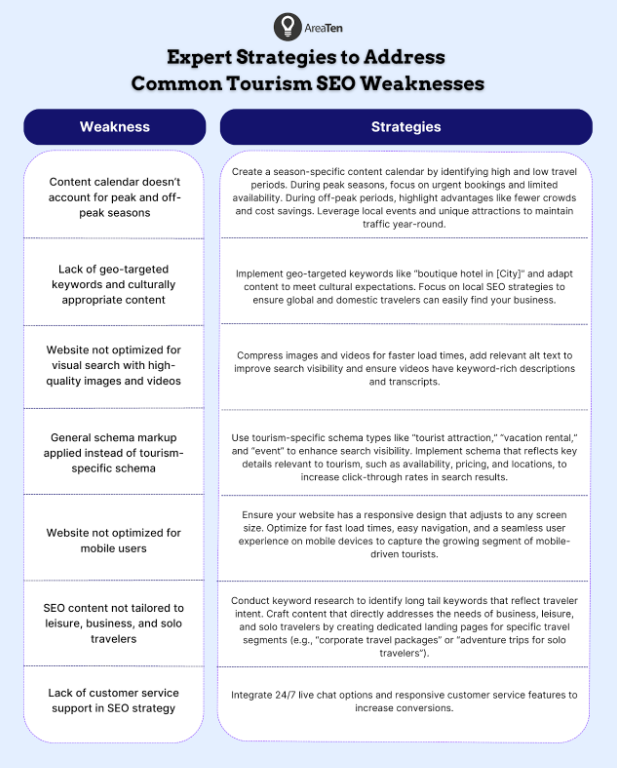
This handy tool is designed to help you pinpoint those pesky areas where your SEO strategy might be falling short. No more guessing—just practical insights that let you take action right away.
You can download it here: Expert Strategies to Address Common Tourism SEO Weaknesses
Whether it’s lagging rankings or missed keyword opportunities, this guide ensures you’re not left in the dark. With everything laid out in one place, you’ll be able to course-correct your strategy and keep your business competitive and agile in this competitive industry.
Tourism SEO for businesses in Darwin and beyond can feel like you’re trying to hit a moving target. The competition’s fierce, and it often feels like no matter what you do, the needle barely moves.
Area Ten aims to bridge the gap by focusing on data-driven strategies that impacts your bottom line. Instead of just getting you meaningless traffic or rankings boosts, our strategies drive real, measurable results for your business.
Here’s how we can help:
When you’re in the tourism business, targeting popular keywords can feel like swimming in a sea of competitors.
Everyone’s fighting over the same few broad search terms, leaving little room to stand out. But here’s the thing—you don’t need to go head-to-head with everyone else. Instead, focus on long tail keywords, which represent niche searches that make up a whopping 90% of search opportunities.
These keywords might not be as popular, but they often reflect a more specific intent from searchers who are much more likely to start spending on your services.
With our proprietary programmatic SEO technology, CMAX, we’re able to tap into these long tail keywords at scale, producing dynamic, location-specific content tailored to numerous search opportunities—far more than what your competitors are likely targeting.
Imagine being the top option that shows up when someone searches for a unique travel experience in a specific region. That’s where the magic happens, and it’s how you get more tourists without battling for the same overcrowded keywords.
This technology doesn’t just churn out generic content either. It creates content that evolves and adapts, keeping pace with seasonal trends, shifting travel patterns, and emerging destinations. So, as people start looking for new places to visit or return to their favorite spots, your business stays relevant, visible, and ready to attract high-intent travelers.
Our approach combines the latest in SEO tech with real human insights, so as search trends change, your business stays visible to high-intent travelers.
Have you been having trouble finding the right tourism hospitality SEO agency?
When it comes to standing out in the crowded tourism industry, you don’t need more noise—you need precision. That’s where Area Ten comes in. We’ve been perfecting our programmatic SEO technology to boost your visibility 4x faster than traditional methods, getting your brand in front of the right audience quicker.
We get it—outdated SEO strategies can be frustrating. But you don’t have to settle for slow, unpredictable results. With over a decade of hands-on experience, our team knows how to cut through the fluff and deliver what matters: dependable growth and scalability.
So, why wait? Help your brand achieve its full potential by inquiring about our FREE SEO Fast Track today.
Book a free video consultation below to see how your SEO & Paid Media campaigns are performing against global benchmarks in your industry.
We’ll uncover tangible opportunities to grow your business in just 6 weeks, including: